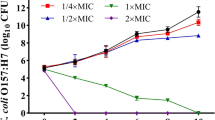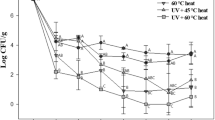Abstract
Ozone has a broad antimicrobial spectrum and each microorganism species has inherent sensitivity to the gas. The objective of this study was to evaluate the effect of ozone gas on Escherichia coli O157:H7 inoculated on an organic substrate, and the efficacy of ozonated water in controlling the pathogen. For the first experiment, E. coli O157:H7 (ATCC® 43890™) was inoculated in milk with different compositions and in water, which was ozonated at concentrations of 35 and 45 mg L−1 for 0, 5, 15, and 25 min. In the second experiment, water was ozonated at 45 mg L−1 for 15 min. E. coli O157:H7 was exposed for 5 min to the ozonated water immediately after ozonation, and after storage for 0.5, 1.0, 1.5, 3.0, and 24 h at 8 °C. The results showed that the composition of the organic substrate interfered with the action of ozone on E. coli O157:H7. In lactose-free homogenized skim milk, reductions of 1.5 log cycles were obtained for ozonation periods of 25 min at the concentrations tested. Ozonated water was effective in inactivating of E. coli O157:H7 in all treatments. The efficiency of ozone on E. coli O157:H7 is influenced by the composition of the organic substrates, reinforcing the need for adequate removal of organic matter before sanitization. Furthermore, refrigerated ozonated water stored for up to 24 h is effective in the control of E. coli O157:H7.

Similar content being viewed by others
References
Franco BD, Landgraf M (2008) Microbiologia dos alimentos, 2nd edn. Atheneu, São Paulo
Davidson PM, Branen AL (2005) Food antimicrobials – an introduction. In: Davidson PM, Sofos JN, Branen AL (eds) Antimicrobials in food. CRC Press, Boca Raton, pp 1–10
Campos LC, Trabulsi LR (2002) Escherichia. In: Trabulsi LR, Alterthum F, Gompertz OF, Candeias JAN (eds) Microbiologia. Atheneu, São Paulo, pp 215–228
Chernaki-Leffer AM, Biesdorf SM, Almeida LM, Leffer EV, Vigne F (2002) Isolamento de enterobactérias em Alphitobius diaperinus e na cama de aviários no oeste do estado do Paraná, Brasil. Rev Bras Cienc Avic 4:243–247
Blanco M, Blanco JE, Mora A, Rey J, Alonso JM, Hermoso M, Hermoso J, Alonso MP, Dahbi G, Gonzalez EA, Bernardez MI, Blanco J (2003) Serotypes, virulence genes, and intimin types of Shiga toxin (verotoxin)-producing Escherichia coli isolates from healthy sheep in Spain. J Clin Microbiol 41:1351–1356
Pianciola L, Chinen I, Mazzeo M, Miliwebsky E, González G, Muller C (2014) Genotypic characterization of Escherichia coli O157:H7 strains that cause diarrhea and hemolytic uremic syndrome in Neuquén, Argentina. J Med Microbiol 304:499–504
CDC – Centers for Disease Control and Prevention (2014) Multistate outbreak of Shiga toxin-producing Escherichia coli O157:H7 infections linked to ground beef (final update). http://www.cdc.gov/ecoli/2014/O157H7-05-14/index.html/. Accessed 20 Dec 2015
Lund BM, O'Brien SJ (2009) Microbiological safety of food in hospitals and other healthcare settings. J Hosp Infect 73:109–120
Feng P, Weagant SD, Jinneman K (2011) BAM: diarrheagenic Escherichia coli. http://www.fda.gov/Food/FoodScienceResearch/LaboratoryMethods/ucm070080.htm/. Accessed 10 Nov 2015
Liu Y, Gill A, McMullen L, Ganzle MG (2015) Variation in heat and pressure resistance of verotoxigenic and nontoxigenic Escherichia coli. J Food Prot 78:111–120
Nascimento MS, Silva N, Catanozi MP, Silva KC (2003) Effects of different disinfection treatments on the natural microbiota of lettuce. J Food Prot 66:1697–1700
Chen Y, Wang H, Xu Y, Wu J, Xiao G (2013) Effect of treatment with dimethyl dicarbonate on microorganisms and quality of chinese cabbage. Postharvest Biol Technol 76:139–144
Selma MV, Ibaneza AM, Allende A, Cantwella M, Suslow T (2008) Effect of gaseous ozone and hot water on microbial and sensory quality of cantaloupe and potential transference of Escherichia coli O157:H7 during cutting. Food Microbiol 25:162–168
Shen C, Luo Y, Nan X et al (2012) Enhanced inactivation of Salmonella and Pseudomonas biofilms on stainless steel by use of t-128, a fresh-produce washing aid, in chlorinated wash solutions. Appl Environ Microbiol 78:6789–6798
Alvaro JE, Moreno S, Dianez F, Santos M, Carrasco G, Urrestarazu M (2009) Effects of peracetic acid disinfectant on the postharvest of some fresh vegetables. J Food Eng 95:11–15
Rahman SM, Jin YG, Oh DH (2011) Combination treatment of alkaline electrolyzed water and citric acid with mild heat to ensure microbial safety, shelf-life and sensory quality of shredded carrots. Food Microbiol 28:484–491
Cavalcante DA, Leite Júnior BR, Tribst AA, Cristianini M (2014) Inativação de Escherichia coli O157:H7 e Bacillus subtilis por água ozonizada. B Cent Pesqui Proc 32:105–112
Cavalcante DA, Leite Júnior BR, Tribst AA, Cristianini M (2015) Vida de prateleira de alface americana tratada com água ozonizada. Cienc Rural 45:2089–2096
FDA - Food and Drug Administration (2001) Secondary direct food additives permitted in food for human consumption. https://www.gpo.gov/fdsys/pkg/FR-2001-06-26/html/01-15963.htm/. Accessed 20 June 2018
Guzel-Seydim Z, Greene AK, Seydim AC (2004) Use of ozone in the food industry. Food Sci Technol 37:453–460
Cullen PJ, Tiwari BK, O'Donnell CP, Muthukumarappan K (2009) Modelling approaches to ozone processing of liquid foods. Trends Food Sci Technol 20:125–136
Kim J, Yousef AE, Dave S (1999) Application of ozone for enhancing the microbiological safety and quality of foods: a review. J Food Prot 62:1071–1087
Clescerl LS, Greenberg AE, Eaton AD (1999) Standard methods for the examination of water and wastewater, 20th edn. American Water Works Association, Denver
Couto EP, Alencar ER, Gonçalves VSP, Santos AJ, Ribeiro JL, Ferreira M (2016) Effect of ozonation on the Staphylococcus aureus innoculated in milk. Semina Cienc Agrar 37:1911–1918
Khadre M, Yousef AE, Kim J (2001) Microbiological aspects of ozone applications in food: a review. J Food Sci 66:1242–1252
Alwi NA, Ali A (2014) Reduction of Escherichia coli O157, Listeria monocytogenes and Salmonella enterica sv. Typhimurium populations on fresh-cut bell pepper using gaseous ozone. Food Control 46:304–311
Sung HJ, Song WJ, Kim KP, Ryu S, Kang DH (2014) Combination effect of ozone and heat treatments for the inactivation of Escherichia coli O157:H7, Salmonella typhimurium, and Listeria monocytogenes in apple juice. J Food Microbiol 171:147–153
Sanchez BA, Alencar ER, Pineli LL, Ferreira WF, Roberto MA (2016) Tracing interactions among column height, exposure time and gas concentration to dimension peanut antifungal ozonation. Food Sci Technol 65:668–675
Manousaridis G, Nerantzaki A, Paleologos EK, Tsiotsias A, Savvaidis IN, Kontominas MG (2005) Effect of ozone on microbial, chemical and sensory attributes of shucked mussels. Food Microbiol 22:1–9
Restaino L, Frampton E, Hemphill J, Palnikar P (1995) Efficacy of ozonated water against various food-related microorganisms. Appl Environ Microbiol 61:3471–3475
Güzel-Seydim Z, Bever PI, Greene AK (2004) Efficacy of ozone to reduce bacterial populations in the presence of food components. Food Microbiol 21:475–479
Choi MR, Liu Q, Lee SY, Jin JH, Ryu S, Kang DH (2012) Inactivation of Escherichia coli O157:H7, Salmonella typhimurium and Listeria monocytogenes in apple juice with gaseous ozone. Food Microbiol 32:191–195
Beltrán FJ (2005) Ozone reaction kinetics for water and wastewater systems, 1st edn. CRC Press, Boca Raton
Berton A, Rouvellac S, Robert B, Rousseau F, Lopez C, Cremon I (2012) Effect of the size and interface composition of milk fat globules on their in vitro digestion by the human pancreatic lipase: native versus homogenized milk fat globules. Food Hydrocoll 29:123–134
Graves E, Beaulieu A, Drackley J (2007) Factors affecting the concentration of sphingomyelin in bovine milk. J Dairy Sci 90:706–715
Mari M, Bertolini P, Pratella G (2003) Non-conventional methods for the control of post-harvest pear diseases. J Appl Microbiol 94:761–766
Beltrán D, Selma MV, Alicia M, Gil MI (2005) Ozonated water extends the shelf life of fresh-cut lettuce. J Agric Food Chem 53:5654–5663
Inatsu Y, Kitagawa T, Nakamura N, Kawasaki S (2013) Effectiveness of stable ozone microbubble containing water on reducing bacteria load on selected leafy vegetables. Acta Hortic (989):161–166
Tachikawa M, Yamanaka K, Nakamuro K (2009) Studies on the disinfection and removal of biofilms by ozone water using an artificial microbial biofilm system. Ozone Sci Eng 31:3–9
Author information
Authors and Affiliations
Corresponding author
Ethics declarations
Conflicts of interest
The authors declare that they have no conflicts of interest.
Additional information
Responsible Editor: Luis Augusto Nero
Publisher’s Note
Springer Nature remains neutral with regard to jurisdictional claims in published maps and institutional affiliations.
Rights and permissions
About this article
Cite this article
de Oliveira Souza, S.M., de Alencar, E.R., Ribeiro, J.L. et al. Inactivation of Escherichia coli O157:H7 by ozone in different substrates. Braz J Microbiol 50, 247–253 (2019). https://doi.org/10.1007/s42770-018-0025-2
Received:
Accepted:
Published:
Issue Date:
DOI: https://doi.org/10.1007/s42770-018-0025-2




